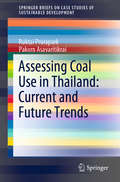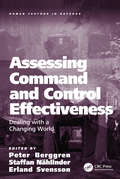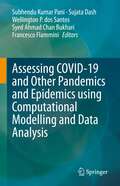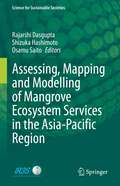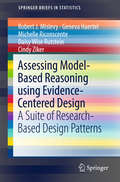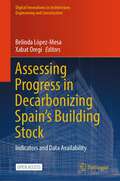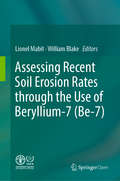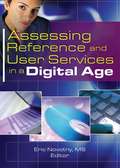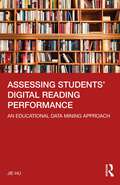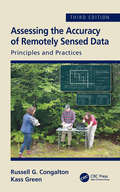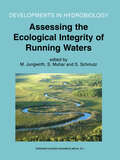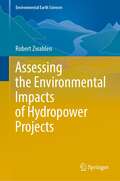- Table View
- List View
Assessing Coal Use in Thailand: Current and Future Trends (SpringerBriefs on Case Studies of Sustainable Development)
by Ruktai Prurapark Pakorn AsavaritikraiThis book highlights Thailand’s growing demand for clean energy from coal. The main source of energy for electricity production in Thailand (70%) is currently natural gas. However, natural gas extraction remains limited, resulting in an increasing need to import natural gas from other countries, which in turn leads to rising prices and unstable supplies. As such, coal energy is essential for industrial use and electricity production in Thailand. The book discusses the importance of developing and implementing clean technologies for coal. It also argues that collaborations between the government, private sector and the public are vital to achieving a mutual understanding and acceptance of coal energy and clean technologies, as well as a reduction in harmful emissions.
Assessing Command and Control Effectiveness: Dealing with a Changing World (Human Factors in Defence)
by Peter Berggren Staffan Nählinder Erland SvenssonAssessing Command and Control Effectiveness: Dealing with a Changing World offers a description of the current state of Command and Control (C2) research in imperfect settings, showing how a research process should assess, analyse and communicate results to the development cycle of methods, work, manning and C2-technology. Special attention is given to the development of C2 research methods to meet the current and coming needs. The authors also look forward towards a future where effective assessment of C2 abilities are even more crucial, for instance in agile organisations. The purpose of the C2 research is to improve the process and make it more effective while still saving time and money. Research methods have to be chosen carefully to be effective and simple, yet provide results of high quality. The methodological concerns are a major consideration when working under such circumstances. Furthermore, there is often a need for a swift iterative development cycle, and thus a demand to quickly deliver results from the research process. This book explains how field research experimentation can be quick, simple and effective, being able to draw valid conclusions even when sample sizes are small and resources are limited, collecting empirical data using measures and procedures that are minimally intrusive.
Assessing Command and Control Effectiveness: Dealing with a Changing World (Human Factors in Defence)
by Peter Berggren Staffan Nählinder Erland SvenssonAssessing Command and Control Effectiveness: Dealing with a Changing World offers a description of the current state of Command and Control (C2) research in imperfect settings, showing how a research process should assess, analyse and communicate results to the development cycle of methods, work, manning and C2-technology. Special attention is given to the development of C2 research methods to meet the current and coming needs. The authors also look forward towards a future where effective assessment of C2 abilities are even more crucial, for instance in agile organisations. The purpose of the C2 research is to improve the process and make it more effective while still saving time and money. Research methods have to be chosen carefully to be effective and simple, yet provide results of high quality. The methodological concerns are a major consideration when working under such circumstances. Furthermore, there is often a need for a swift iterative development cycle, and thus a demand to quickly deliver results from the research process. This book explains how field research experimentation can be quick, simple and effective, being able to draw valid conclusions even when sample sizes are small and resources are limited, collecting empirical data using measures and procedures that are minimally intrusive.
Assessing COVID-19 and Other Pandemics and Epidemics using Computational Modelling and Data Analysis
by Subhendu Kumar Pani Sujata Dash Wellington P. dos Santos Syed Ahmad Chan Bukhari Francesco FlamminiThis book comprehensively covers the topic of COVID-19 and other pandemics and epidemics data analytics using computational modelling. Biomedical and Health Informatics is an emerging field of research at the intersection of information science, computer science, and health care. The new era of pandemics and epidemics bring tremendous opportunities and challenges due to the plentiful and easily available medical data allowing for further analysis. The aim of pandemics and epidemics research is to ensure high-quality, efficient healthcare, better treatment and quality of life by efficiently analyzing the abundant medical, and healthcare data including patient’s data, electronic health records (EHRs) and lifestyle. In the past, it was a common requirement to have domain experts for developing models for biomedical or healthcare. However, recent advances in representation learning algorithms allow us to automatically learn the pattern and representation of the given data for the development of such models. Medical Image Mining, a novel research area (due to its large amount of medical images) are increasingly generated and stored digitally. These images are mainly in the form of: computed tomography (CT), X-ray, nuclear medicine imaging (PET, SPECT), magnetic resonance imaging (MRI) and ultrasound. Patients’ biomedical images can be digitized using data mining techniques and may help in answering several important and critical questions related to health care. Image mining in medicine can help to uncover new relationships between data and reveal new and useful information that can be helpful for scientists and biomedical practitioners. Assessing COVID-19 and Other Pandemics and Epidemics using Computational Modelling and Data Analysis will play a vital role in improving human life in response to pandemics and epidemics. The state-of-the-art approaches for data mining-based medical and health related applications will be of great value to researchers and practitioners working in biomedical, health informatics, and artificial intelligence..
Assessing Environmental Risk of Oil Spills with ERA Acute: A New Methodology (SpringerBriefs in Environmental Science)
by Cathrine Stephansen Anders Bjørgesæter Odd Willy Brude Ute Brönner Tonje Waterloo Rogstad Grethe Kjeilen-Eilertsen Jean-Marie Libre Christian Collin-HansenThis open access book introduces readers to a new methodology for assessing the risks to the marine environment following accidental oil spills. The methodology will soon be implemented on the Norwegian Continental Shelf and will be complemented by guidelines for its use in a regulatory framework. The brief book is intended to provide international readers with a basic grasp of what the ERA Acute methodology consists of, what its applications are, and the underlying impact and restoration models used in its development. The content is divided into three main parts: an introduction and overview of risk management applications for generalists at the management level, a model overview for generalist scientists, and a more detailed final section for risk assessment professionals, which presents the results of the validation and sensitivity testing.
Assessing Fault Model and Test Quality (The Springer International Series in Engineering and Computer Science #157)
by Kenneth M. Butler M. Ray MercerFor many years, the dominant fault model in automatic test pattern gen eration (ATPG) for digital integrated circuits has been the stuck-at fault model. The static nature of stuck-at fault testing when compared to the extremely dynamic nature of integrated circuit (IC) technology has caused many to question whether or not stuck-at fault based testing is still viable. Attempts at answering this question have not been wholly satisfying due to a lack of true quantification, statistical significance, and/or high computational expense. In this monograph we introduce a methodology to address the ques tion in a manner which circumvents the drawbacks of previous approaches. The method is based on symbolic Boolean functional analyses using Or dered Binary Decision Diagrams (OBDDs). OBDDs have been conjectured to be an attractive representation form for Boolean functions, although cases ex ist for which their complexity is guaranteed to grow exponentially with input cardinality. Classes of Boolean functions which exploit the efficiencies inherent in OBDDs to a very great extent are examined in Chapter 7. Exact equa tions giving their OBDD sizes are derived, whereas until very recently only size bounds have been available. These size equations suggest that straight forward applications of OBDDs to design and test related problems may not prove as fruitful as was once thought.
Assessing Forest Ecosystem Health in the Inland West
by David L. AdamsInland West, their historical origins, assessments of available management tools, and analyses of the various choices available to policymakers. Its goal is to help people understand the Inland West forests so that public policies can reflect a constructive and realistic framework in which forests can be managed for sustained health. This resource is the product of a scientific workshop where 35 participants, including scientists, resource managers, administrators, and environmentalists, addressed the forest health problem in the Inland West. Synthesis chapters integrate the diverse knowledge and experience which participants brought to the workshop. They identify and link together many of the ecological, social, and administrative conditions which have created the forest health problem in the West. The book is unique in that it reflects a process that fostered the use of academic research, field realities, and industrial knowledge to define an interdisciplinary problem, establish rational policy objectives, and set-up “do-able” management approaches.The following topics are analyzed: Assessing forest ecosystem health in the Inland West Historical and anticipated changes in forest ecosystems in the Inland West Defining and measuring forest health Historical range of variability as a tool for evaluating ecosystem change Administrative barriers to implementing forest health problems Economic and social dimensions of the forest health problem Fire management Ecosystem and landscape management
Assessing Forest Ecosystem Health in the Inland West
by David L. AdamsInland West, their historical origins, assessments of available management tools, and analyses of the various choices available to policymakers. Its goal is to help people understand the Inland West forests so that public policies can reflect a constructive and realistic framework in which forests can be managed for sustained health. This resource is the product of a scientific workshop where 35 participants, including scientists, resource managers, administrators, and environmentalists, addressed the forest health problem in the Inland West. Synthesis chapters integrate the diverse knowledge and experience which participants brought to the workshop. They identify and link together many of the ecological, social, and administrative conditions which have created the forest health problem in the West. The book is unique in that it reflects a process that fostered the use of academic research, field realities, and industrial knowledge to define an interdisciplinary problem, establish rational policy objectives, and set-up “do-able” management approaches.The following topics are analyzed: Assessing forest ecosystem health in the Inland West Historical and anticipated changes in forest ecosystems in the Inland West Defining and measuring forest health Historical range of variability as a tool for evaluating ecosystem change Administrative barriers to implementing forest health problems Economic and social dimensions of the forest health problem Fire management Ecosystem and landscape management
Assessing Innovation: Metrics, Rubrics, and Standards (Systems Innovation Book Series)
by Adedeji B. Badiru Melinda TourangeauWe cannot manage and control what we cannot measure and assess. Poor assessment results have been cited as a primary reason for project failures, in terms of cost, schedule, and quality. This book introduces metrics, rubrics, and standards pertinent to assessing innovation.Assessing Innovation: Metrics, Rubrics, and Standards provides a new view for the embracing of innovation and establishing a quantitative basis for determining innovation levels. It bridges innovation with practice and presents a systems view as it incorporates the human element and discusses the different roles carried out. This book offers standards that will guide readers as they tackle sustaining innovation and leverages Badiru’s Umbrella Model in the process.The inclusion of methodologies suitable for determining where and when innovation is happening, and to what extent it is currently being carried out, make this a unique book, along with being the only book that addresses innovation metrics, rubrics, and standards in an integrated fashion. Seen as a way to help advance the diverse pursuit of innovation, this book is an ideal read for those in engineering, business, industry, academia, government, and the military.
Assessing Innovation: Metrics, Rubrics, and Standards (Systems Innovation Book Series)
by Adedeji B. Badiru Melinda TourangeauWe cannot manage and control what we cannot measure and assess. Poor assessment results have been cited as a primary reason for project failures, in terms of cost, schedule, and quality. This book introduces metrics, rubrics, and standards pertinent to assessing innovation.Assessing Innovation: Metrics, Rubrics, and Standards provides a new view for the embracing of innovation and establishing a quantitative basis for determining innovation levels. It bridges innovation with practice and presents a systems view as it incorporates the human element and discusses the different roles carried out. This book offers standards that will guide readers as they tackle sustaining innovation and leverages Badiru’s Umbrella Model in the process.The inclusion of methodologies suitable for determining where and when innovation is happening, and to what extent it is currently being carried out, make this a unique book, along with being the only book that addresses innovation metrics, rubrics, and standards in an integrated fashion. Seen as a way to help advance the diverse pursuit of innovation, this book is an ideal read for those in engineering, business, industry, academia, government, and the military.
Assessing, Mapping and Modelling of Mangrove Ecosystem Services in the Asia-Pacific Region (Science for Sustainable Societies)
by Rajarshi Dasgupta Shizuka Hashimoto Osamu SaitoThis book presents the state-of-the-art of knowledge in assessing, mapping, and modeling mangrove ecosystem services and outlines various scientific tools and techniques, including environmental scenario-building, spatial and econometric modelling to understand the fluctuations and future availability of mangrove ecosystem services. The book also highlights the current gaps and measures in policy planning and outlines the avenues for capacity building. Through case studies and thematic reviews, the book plans to cater to a wide range of audiences, including students, researchers, and decision-makers at various levels involved in mangrove conservation and land use optimization for sustainable and resilient development. This book is particularly useful to researchers and students in the field of landscape and spatial ecology, coastal zone management, ecosystem services, and resilience planning. It is also a must-read for policymakers, conservators, coastal zone managers, foresters, and general administrators in understanding the current and future roles of mangroves in ecosystem-based adaptation through informed decision-making.
Assessing Model-Based Reasoning using Evidence- Centered Design: A Suite of Research-Based Design Patterns (SpringerBriefs in Statistics)
by Robert J Mislevy Geneva Haertel Michelle Riconscente Daisy Wise Rutstein Cindy ZikerThis Springer Brief provides theory, practical guidance, and support tools to help designers create complex, valid assessment tasks for hard-to-measure, yet crucial, science education standards. Understanding, exploring, and interacting with the world through models characterizes science in all its branches and at all levels of education. Model-based reasoning is central to science education and thus science assessment. Current interest in developing and using models has increased with the release of the Next Generation Science Standards, which identified this as one of the eight practices of science and engineering. However, the interactive, complex, and often technology-based tasks that are needed to assess model-based reasoning in its fullest forms are difficult to develop. Building on research in assessment, science education, and learning science, this Brief describes a suite of design patterns that can help assessment designers, researchers, and teachers create tasks for assessing aspects of model-based reasoning: Model Formation, Model Use, Model Elaboration, Model Articulation, Model Evaluation, Model Revision, and Model-Based Inquiry. Each design pattern lays out considerations concerning targeted knowledge and ways of capturing and evaluating students’ work. These design patterns are available at http://design-drk.padi.sri.com/padi/do/NodeAction?state=listNodes&NODE_TYPE=PARADIGM_TYPE. The ideas are illustrated with examples from existing assessments and the research literature.
Assessing Progress in Decarbonizing Spain’s Building Stock: Indicators and Data Availability (Digital Innovations in Architecture, Engineering and Construction)
by Belinda López-Mesa Xabat OregiThis open access book delves into the topic of monitoring the effectiveness of building renovation policies within the European Union (EU) using indicators. Given the substantial environmental impact of existing buildings on energy consumption and greenhouse gas emissions, decarbonizing them is imperative for achieving climate neutrality in Europe. The use of indicators for monitoring decarbonization progress and evaluating policies emerges as a valuable tool, ensuring the efficiency, effectiveness, and alignment of building renovation policies with broader sustainability and climate objectives. Additionally, this approach facilitates evidence-based decision-making, promotes accountability by Member States (MSs), supports the realization of long-term goals, and actively involves the public in these vital initiatives. The European Commission is actively engaged in this realm, releasing a framework of optional indicators in 2019 and subsequently refining it during the review of the Energy Performance of Buildings Directive. The evolving framework seeks to encompass both mandatory and optional indicators, posing greater challenges for EU MSs in monitoring the impact of their national building renovation policies and the progress of decarbonizing their building stocks. This book offers insights into these developing indicator frameworks, assesses the availability and quality of data in the case of Spain, and suggests areas of improvement and innovative approaches using emerging technologies to enhance data. The target audience includes diverse stakeholders such as central government administrations, regional and municipal authorities, data-collecting institutions, urban planners, researchers, and citizens interested in comprehending the impact of building renovation. By addressing this broad audience, the book aims to foster a more inclusive and well-informed discussion on building renovation and the decarbonization of the European building stock.
Assessing Recent Soil Erosion Rates through the Use of Beryllium-7 (Be-7)
by Lionel Mabit William BlakeThis open access book is the first comprehensive guideline for the beryllium-7 (Be-7) technique that can be applied to evaluate short-term patterns and budgets of soil redistribution in agricultural landscapes. While covering the fundamental and basic concepts of the approach, this book distinguishes itself from other publications by offering step-by-step instructions on how to use this isotopic technique effectively. It covers experimental design considerations and clear instruction is given on data processing. As accurate laboratory measurement is crucial to ensure successful use of Be-7 to investigate soil erosion, a full chapter is devoted to its specific determination by gamma spectrometry. This open access contribution further describes new developments in the Be-7 technique and includes a concluding chapter highlighting its potential benefits to support the implementation of area-wide soil conservation policy.
Assessing Reference and User Services in a Digital Age
by Eric NovotnyEffectively assess whether any library is making good use of the reference/user service resources available todayLibraries need to develop standards by which they can assess their individual performances in a larger context, and Assessing Reference and User Services in a Digital Age makes significant contributions to this ongoing discussion. The book addresses its subject matter via approaches ranging from case studies of individual libraries to general discussions of best practices. The contributors explore the impact of the Internet on the field of evaluation, focusing on electronic reference and instruction. They highlight current issues, present research results, and offer expert advice on how to assess online reference and instruction. All chapters are well referenced to facilitate further study, and many include tables, appendixes, checklists, and other helpful features that make difficult information easy to access and understand.The chapters that make up Assessing Reference and User Services in a Digital Age are as rich and varied as the backgrounds of their authors. Experienced researchers provide the results of studies conducted to determine the nature and effectiveness of the online reference services offered by various libraries. Practitioners and administrators from different institutional settings (academic libraries, public libraries, consortiums, etc.) provide their perspectives on the issues facing librarians who need to assess the electronic services they provide.In this important new book: Andrew Briedenbagh shows how a chat service can be implemented and suggests which data should be collected for it Buff Hirko examines VET: the Virtual Evaluation Toolkit Ruth Vondracek shares the experiences of a university library as it entered a statewide e-reference consortium, and offers advice and issues to consider before entering such a partnership librarians from San Jose State University present a model for evaluating electronic reference services that can be used in public or academic libraries Kathleen Kern discusses holistic evaluation chat transcripts are addressed in several chapters, including Joseph Fennewald&’s comparisons of question categories, Lesley Moyo&’s analysis of the use of instruction in the virtual environment, and Caleb Tucker-Raymond&’s proposed set of quality measures for chat reference Laurie Probst and Michael Pelikan report on the use of a "Tell Us What You Think" button to gather user feedback Kristi Nelson and Catherine L. Ross examine a research study that asked library school students to submit a reference question online and report on their experiences Melissa Gross, Charles McClure, and R. David Lankes suggest measures to determine the cost and benefits of a virtual reference service librarians from Utah State University describe the development of their online instructional moduleAssessing Reference and User Services in a Digital Age is designed as essential reading for library administrators, public service librarians, and researchers. It provides general advice for practitioners as well as an examination of research results and methodological issues. We urge you to consider making it part of your professional or teaching collection today.
Assessing Reference and User Services in a Digital Age
by Eric NovotnyEffectively assess whether any library is making good use of the reference/user service resources available todayLibraries need to develop standards by which they can assess their individual performances in a larger context, and Assessing Reference and User Services in a Digital Age makes significant contributions to this ongoing discussion. The book addresses its subject matter via approaches ranging from case studies of individual libraries to general discussions of best practices. The contributors explore the impact of the Internet on the field of evaluation, focusing on electronic reference and instruction. They highlight current issues, present research results, and offer expert advice on how to assess online reference and instruction. All chapters are well referenced to facilitate further study, and many include tables, appendixes, checklists, and other helpful features that make difficult information easy to access and understand.The chapters that make up Assessing Reference and User Services in a Digital Age are as rich and varied as the backgrounds of their authors. Experienced researchers provide the results of studies conducted to determine the nature and effectiveness of the online reference services offered by various libraries. Practitioners and administrators from different institutional settings (academic libraries, public libraries, consortiums, etc.) provide their perspectives on the issues facing librarians who need to assess the electronic services they provide.In this important new book: Andrew Briedenbagh shows how a chat service can be implemented and suggests which data should be collected for it Buff Hirko examines VET: the Virtual Evaluation Toolkit Ruth Vondracek shares the experiences of a university library as it entered a statewide e-reference consortium, and offers advice and issues to consider before entering such a partnership librarians from San Jose State University present a model for evaluating electronic reference services that can be used in public or academic libraries Kathleen Kern discusses holistic evaluation chat transcripts are addressed in several chapters, including Joseph Fennewald&’s comparisons of question categories, Lesley Moyo&’s analysis of the use of instruction in the virtual environment, and Caleb Tucker-Raymond&’s proposed set of quality measures for chat reference Laurie Probst and Michael Pelikan report on the use of a "Tell Us What You Think" button to gather user feedback Kristi Nelson and Catherine L. Ross examine a research study that asked library school students to submit a reference question online and report on their experiences Melissa Gross, Charles McClure, and R. David Lankes suggest measures to determine the cost and benefits of a virtual reference service librarians from Utah State University describe the development of their online instructional moduleAssessing Reference and User Services in a Digital Age is designed as essential reading for library administrators, public service librarians, and researchers. It provides general advice for practitioners as well as an examination of research results and methodological issues. We urge you to consider making it part of your professional or teaching collection today.
Assessing Students' Digital Reading Performance: An Educational Data Mining Approach
by Jie HUThis book provides a systematic study of the Programme for International Student Assessment (PISA) based on big data analysis, aiming to examine the contextual factors relevant to students’ digital reading performance. The author first introduces the research landscape of educational data mining (EDM) and reviews the PISA framework since its launch and how it has become an important metric to assess the knowledge and skills of students from across the globe. With a focus on methodology and its applications, the book explores extant scholarship on the dynamic model of educational effectiveness, multi-level factors of digital reading performance, and the application of EDM approaches. The core chapter on the methodology examines machine learning algorithms, hierarchical linear modeling, mediation analysis, and data extraction and processing for the PISA dataset. The findings give insights into the influencing factors of students’ digital reading performance, allowing for further investigations on improving students’ digital reading literacy and more attention to the advancement of education effectiveness. The book will appeal to scholars, professionals, and policymakers interested in reading education, educational data mining, educational technology, and PISA, as well as students learning how to utilize machine learning algorithms in examining the mass global database.
Assessing Students' Digital Reading Performance: An Educational Data Mining Approach
by Jie HUThis book provides a systematic study of the Programme for International Student Assessment (PISA) based on big data analysis, aiming to examine the contextual factors relevant to students’ digital reading performance. The author first introduces the research landscape of educational data mining (EDM) and reviews the PISA framework since its launch and how it has become an important metric to assess the knowledge and skills of students from across the globe. With a focus on methodology and its applications, the book explores extant scholarship on the dynamic model of educational effectiveness, multi-level factors of digital reading performance, and the application of EDM approaches. The core chapter on the methodology examines machine learning algorithms, hierarchical linear modeling, mediation analysis, and data extraction and processing for the PISA dataset. The findings give insights into the influencing factors of students’ digital reading performance, allowing for further investigations on improving students’ digital reading literacy and more attention to the advancement of education effectiveness. The book will appeal to scholars, professionals, and policymakers interested in reading education, educational data mining, educational technology, and PISA, as well as students learning how to utilize machine learning algorithms in examining the mass global database.
Assessing Technology (UK Higher Education OUP Humanities & Social Sciences Education OUP)
by Richard KimbellHow did the development of assessment practices influence the emerging technology curriculum?How does practice in the UK compare to practice in the USA, Germany, Taiwan and Australia?For thirty years the UK has been evolving a distinctive technology curriculum. In part one of this book Richard Kimbell explores the thorny issues of assessment that have been raised by - and that helped to define - the technology curriculum in the UK. Richard writes as an 'insider' who was closely involved in the evolution of GCSE, in the battles that characterised the development of national curriculum assessment, and in the single biggest research venture in the assessment of technology - the Assessment of Performance Unit project of 1985-91. He analyses the successes and the mistakes and brings these together (in chapter 6) into a series of lessons that we should have learned about technology and about assessment.In part two, Richard presents four vignettes of curriculum and assessment practice in technology from the USA, Germany, Taiwan and Australia. In each case the education system, the technology curriculum and its associated assessment practices are outlined. Thereafter - in the final chapter, Richard brings together the lessons learned in the UK with those that might reasonably be learned from practice in the four case study nations.
Assessing the Accuracy of Remotely Sensed Data: Principles and Practices, Third Edition
by Russell G. Congalton Kass GreenThe past 10 years have brought amazing changes to the technologies used to turn remotely sensed data into maps. As a result, the principles and practices necessary for assessing the accuracy of those maps have also evolved and matured. This third edition of Assessing the Accuracy of Remotely Sensed Data: Principles and Practices is thoroughly updated and includes five new chapters. Now 15 chapters long, this text is the only one of its kind to provide geospatial analysts with the requisite considerations, tools, and theory necessary to conduct successful and efficient map accuracy assessments; and map users with the knowledge to fully understand the assessment process to ensure effective use of maps. See What’s New in the Third Edition: All original chapters have been updated to include new standards, practices, and methodologies. A new chapter on planning accuracy assessments. A new chapter on assessing maps created using object-based technologies. Two case study chapters - one showcasing the assessment of maps created from traditional methods, and one on the assessment of object-based maps. Emphasis on considering and planning for positional accuracy in concert with thematic accuracy. An appendix containing the internationally recognized ASPRS Positional Accuracy Standards. A new final chapter summarizing the key concepts, considerations and lessons learned by the authors in their decades of implementing and evaluating accuracy assessments. Assessing map accuracy is complex; however, the discussions in this book, together with the many figures, tables, and case studies, clearly present the necessary concepts and considerations for conducting an assessment that is both is practical, statistically reliable, and achievable.
Assessing the Accuracy of Remotely Sensed Data: Principles and Practices, Third Edition (Mapping Science Ser.)
by Russell G. Congalton Kass GreenThe past 10 years have brought amazing changes to the technologies used to turn remotely sensed data into maps. As a result, the principles and practices necessary for assessing the accuracy of those maps have also evolved and matured. This third edition of Assessing the Accuracy of Remotely Sensed Data: Principles and Practices is thoroughly updated and includes five new chapters. Now 15 chapters long, this text is the only one of its kind to provide geospatial analysts with the requisite considerations, tools, and theory necessary to conduct successful and efficient map accuracy assessments; and map users with the knowledge to fully understand the assessment process to ensure effective use of maps. See What’s New in the Third Edition: All original chapters have been updated to include new standards, practices, and methodologies. A new chapter on planning accuracy assessments. A new chapter on assessing maps created using object-based technologies. Two case study chapters - one showcasing the assessment of maps created from traditional methods, and one on the assessment of object-based maps. Emphasis on considering and planning for positional accuracy in concert with thematic accuracy. An appendix containing the internationally recognized ASPRS Positional Accuracy Standards. A new final chapter summarizing the key concepts, considerations and lessons learned by the authors in their decades of implementing and evaluating accuracy assessments. Assessing map accuracy is complex; however, the discussions in this book, together with the many figures, tables, and case studies, clearly present the necessary concepts and considerations for conducting an assessment that is both is practical, statistically reliable, and achievable.
Assessing the Ecological Integrity of Running Waters: Proceedings of the International Conference, held in Vienna, Austria, 9–11 November 1998 (Developments in Hydrobiology #149)
by M. Jungwirth S. Muhar S. SchmutzThe assessment of the ecological integrity of running waters is a prerequisite to an understanding of the effects of human alterations. The evaluation of degradation processes provides key information on how to avoid further negative impacts. The success of future conservation, mitigation and restoration activities will rely on sound assessment methodologies and their ecological relevance and applicability. Assessment methodologies are therefore an integral part of sustainable river management. This book synthesizes and discusses state-of-the-art experiences in assessment methodologies. Including the latest knowledge on structures, processes and functions of running waters as a fundamental basis for developing adequate assessment methods, the book focuses on method development, application, and in particular on integrated assessment methods. This book is directed at scientists and managers with the aim of more effective preservation, restoration and maintenance of the ecological integrity of running water ecosystems.
Assessing the Environmental Impacts of Hydropower Projects (Environmental Earth Sciences)
by Robert ZwahlenThis book describes the entire process of environmental impact assessment for hydropower and dam projects, not from a legal or regulatory point of view, but from a very applied one, based mainly on the personal experience of the author, who is involved in this field of work since over 40 years, by describing the different steps of such an assessment, covering all major aspects to be dealt with. The focus is on environmental issues, while the other main subject—social impacts—is mentioned here only briefly. It will be of interest not only for ESIA (Environmental and Social Impact Assessment) practitioners, be they consultants involved in the preparation of such studies or staff members of environmental protection agencies having to come to decisions based on them, but also for engineers and planners involved in such projects, developers, and people interested in questions related to energy, environment, and climate change. Overall, this book aims at contributing to put the discussion about hydropower and dam projects on a more objective level.
Assessing the Functional Structure of Molecular Transporters by EPR Spectroscopy (Springer Theses)
by Matthias J.N.JunkIn his thesis, Matthias Junk takes an innovative approach to assess the local structure and dynamics of biological and synthetic amphiphilic macromolecules capable of transporting small molecules. Replacing the latter with stable radicals, he uses state-of-the-art electron paramagnetic resonance (EPR) spectroscopy to describe the highly relevant transport function from the viewpoint of the guest molecules. Such, he demonstrates that the functional structure of human serum albumin in solution significantly differs from its crystal structure – a consequence of the protein’s adaptability to host various endogenous compounds and drug molecules. Further, he shows that the thermal collapse of thermoresponsive hydrogels and dendronized polymers leads to static and dynamic heterogeneities on the nanoscale. These heterogeneities bear consequences for the material’s hosting properties and enable unforeseen complex catalytic functionalities.
Assessing the Impacts of Climate Change on Natural Resource Systems
by Norman J. Rosenberg Kenneth D. FrederickThis volume characterizes the current state of natural science and socioeconomic modeling of the impacts of climate change and current climate variability on forests, grasslands, and water. It identifies what can be done currently with impact assessments and suggests how to undertake such assessments. Impediments to linking biophysical and socioeconomic models into integrated assessments for policy purposes are identified, and recommendations for future research activities to improve the state of the art and remove these impediments to model integration are provided. This book is for natural and social scientists with an interest in the impacts of climate change on terrestrial and aquatic ecosystems and their socioeconomic impacts, and policy makers interested in understanding the status of current assessment capabilities and in identifying priority areas for future research.
